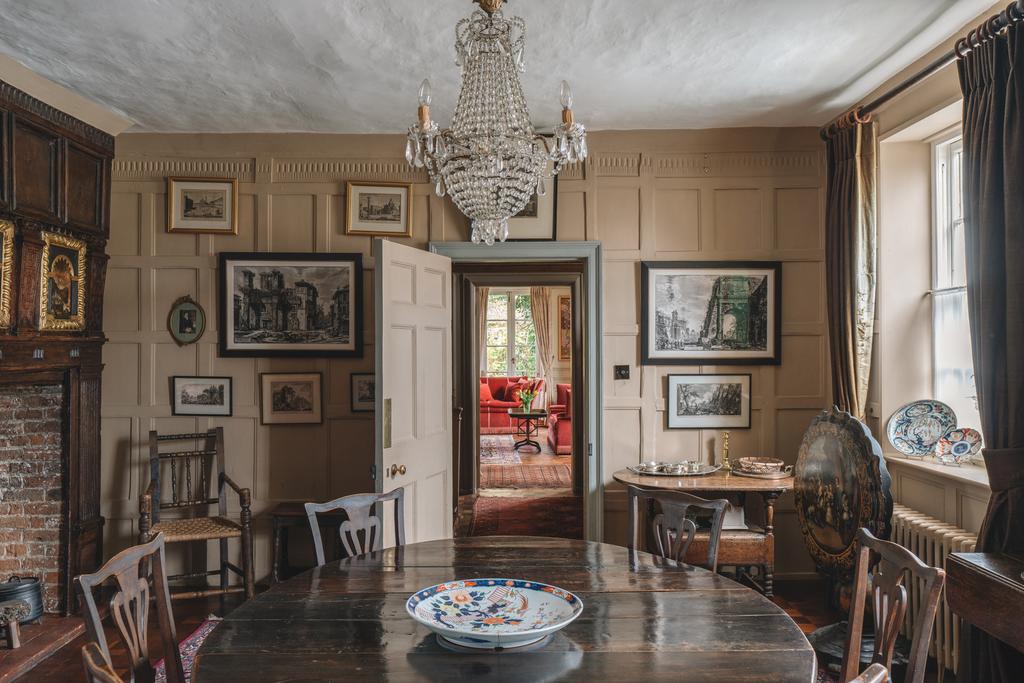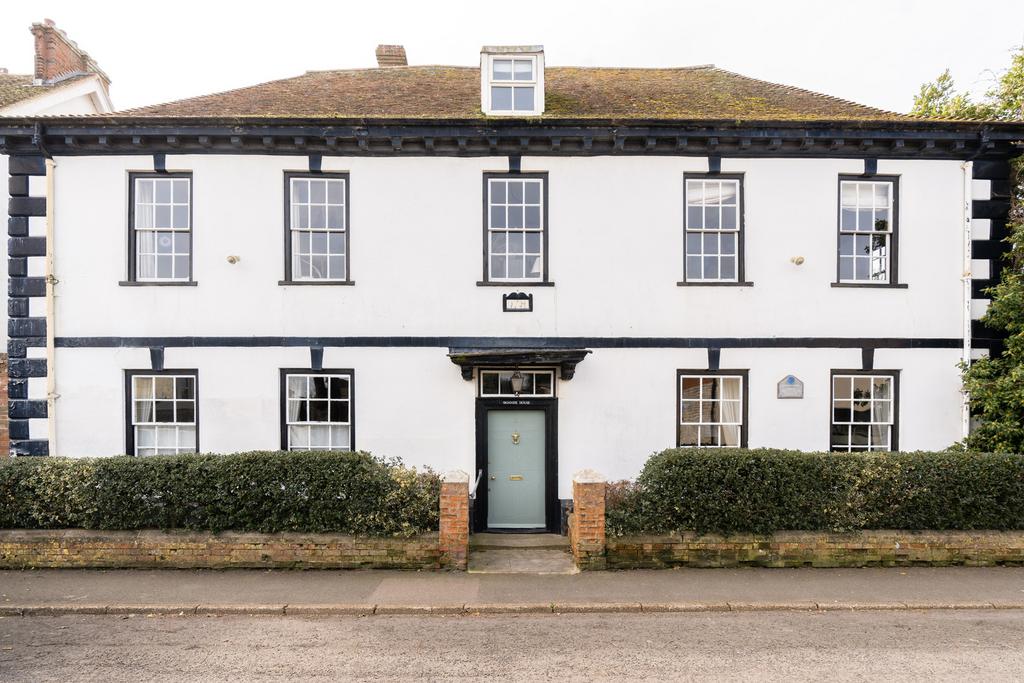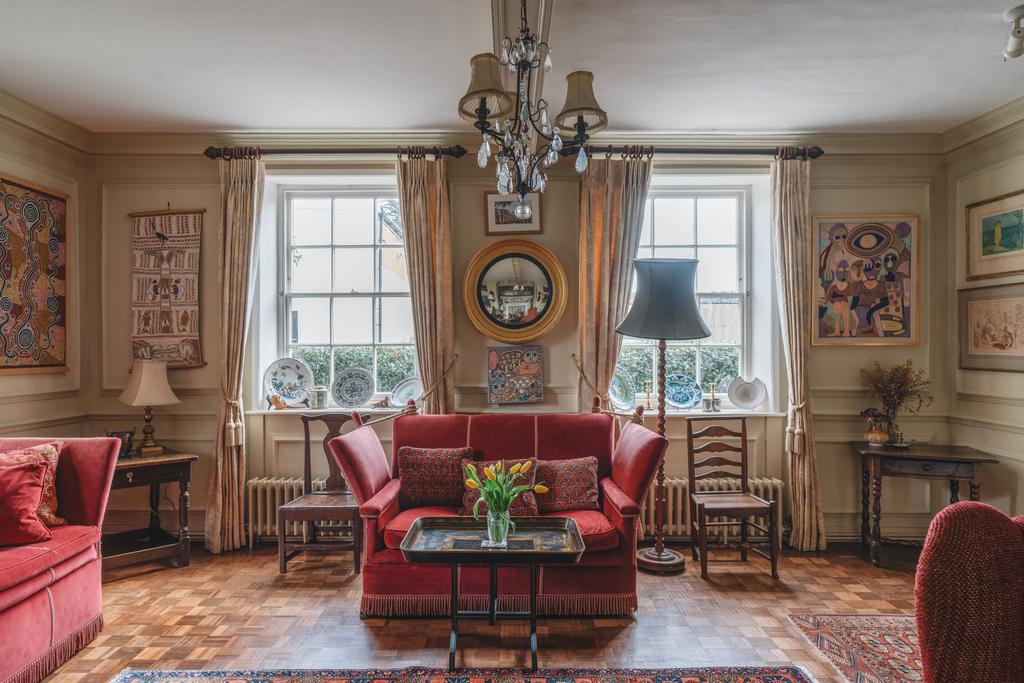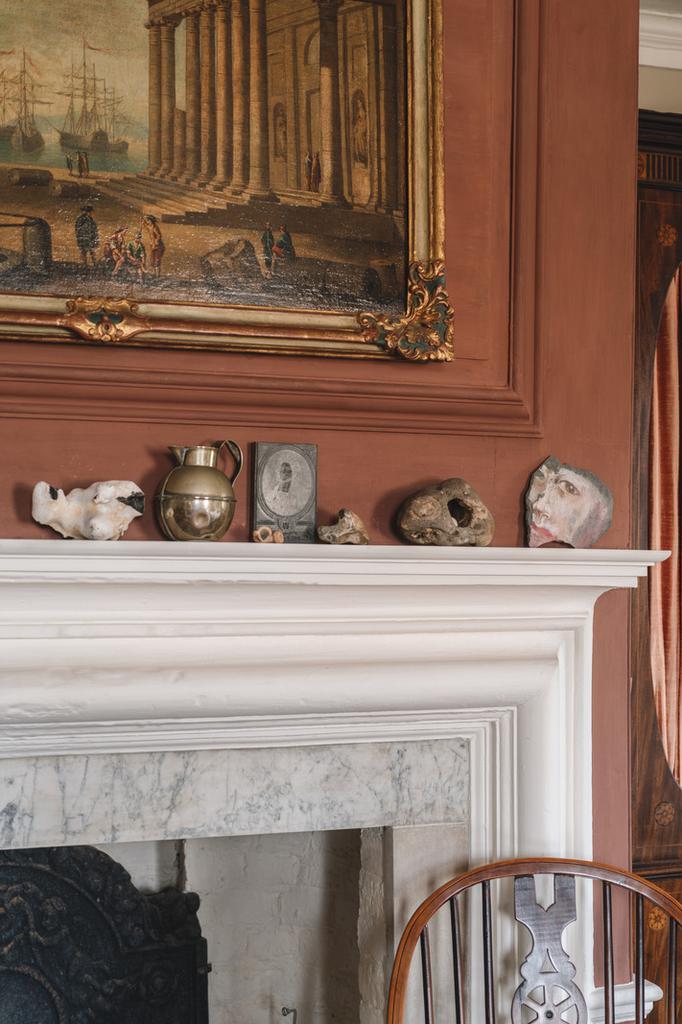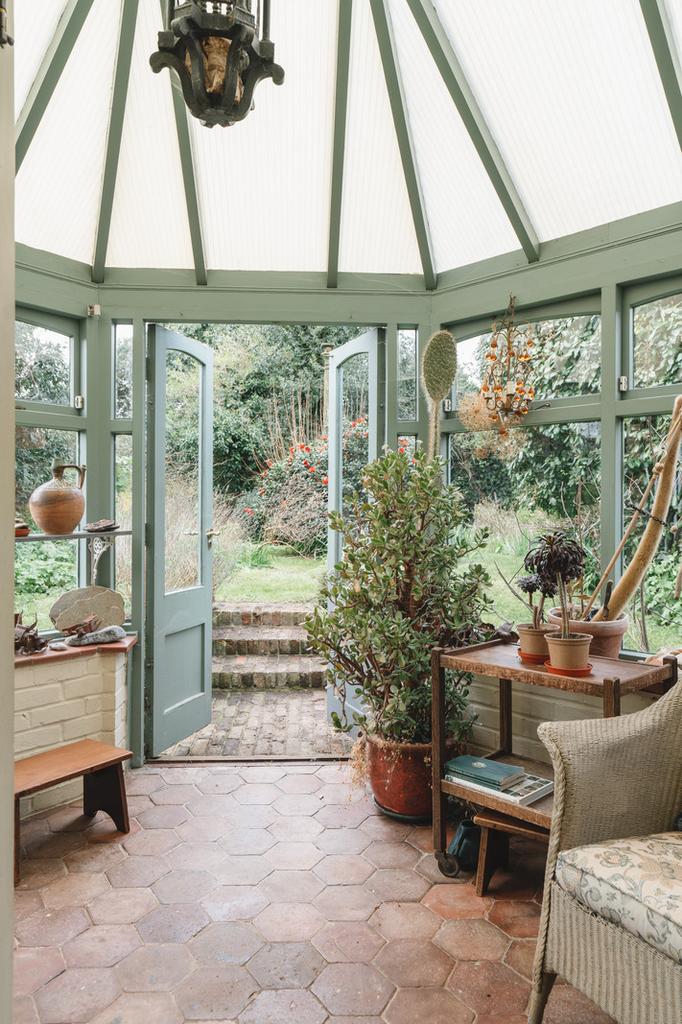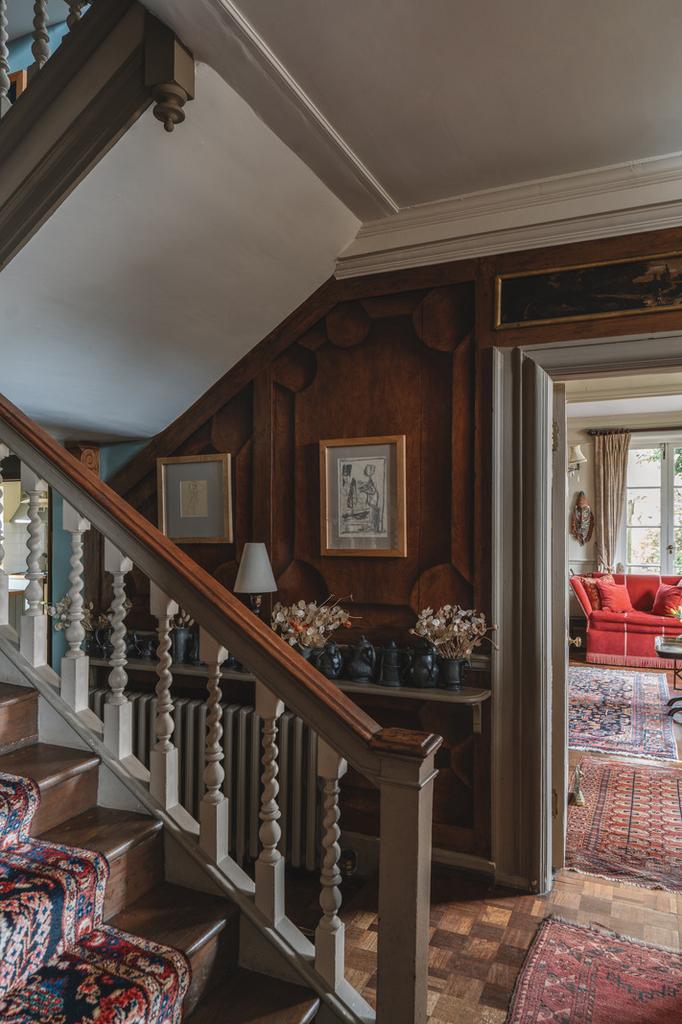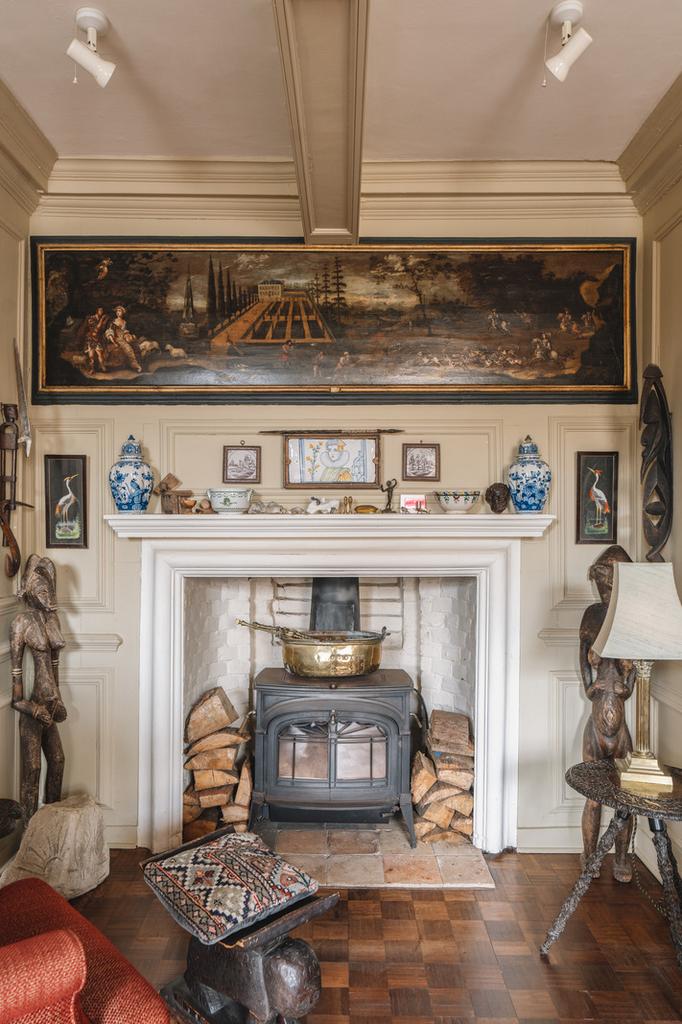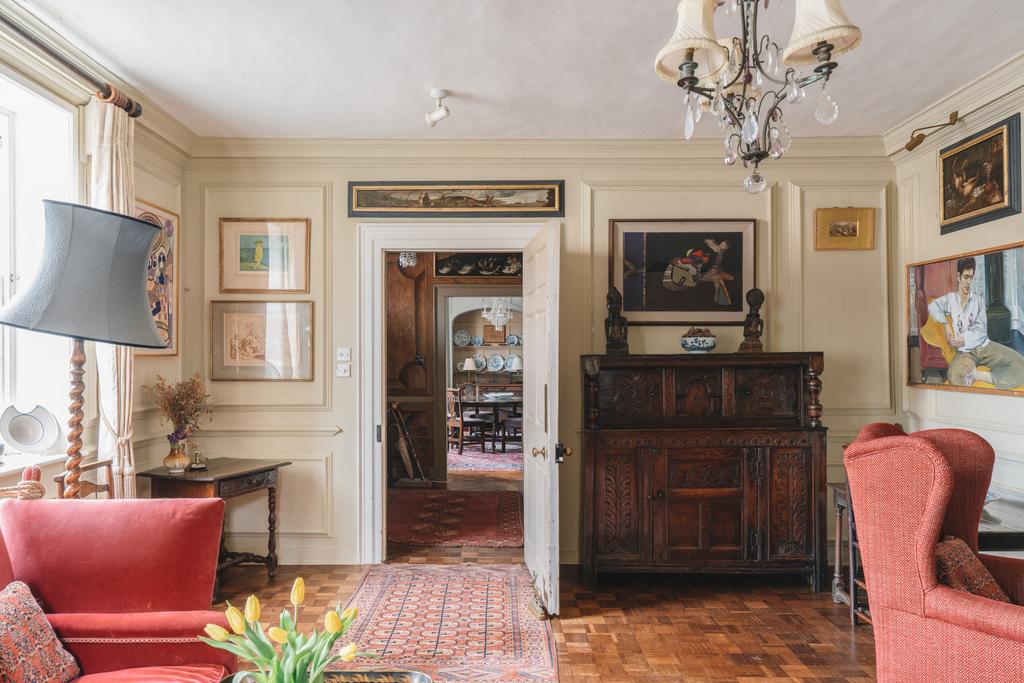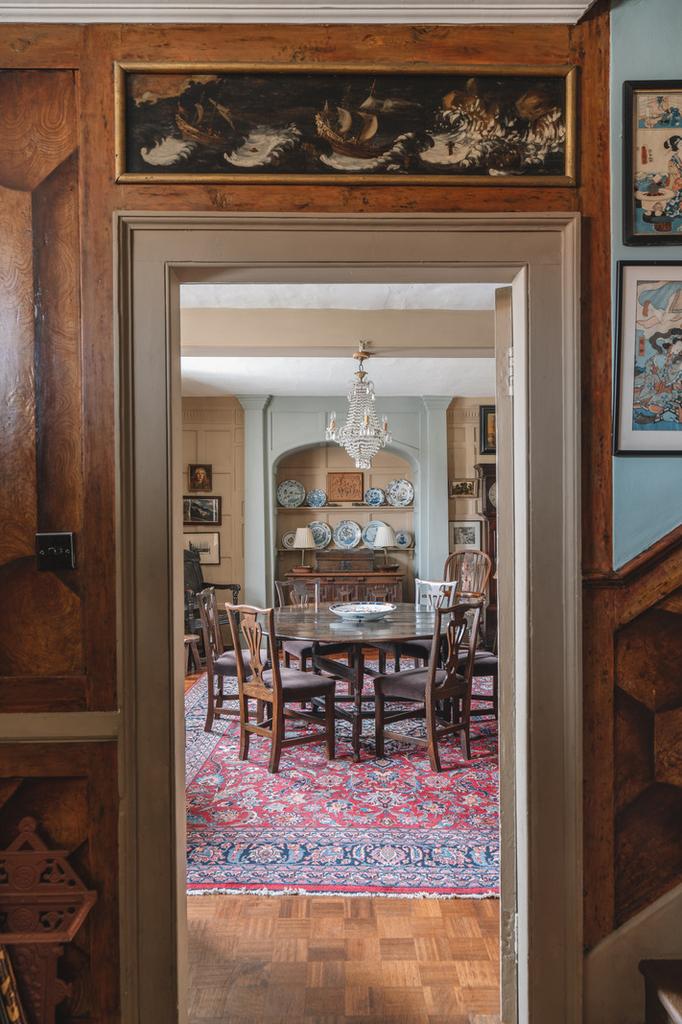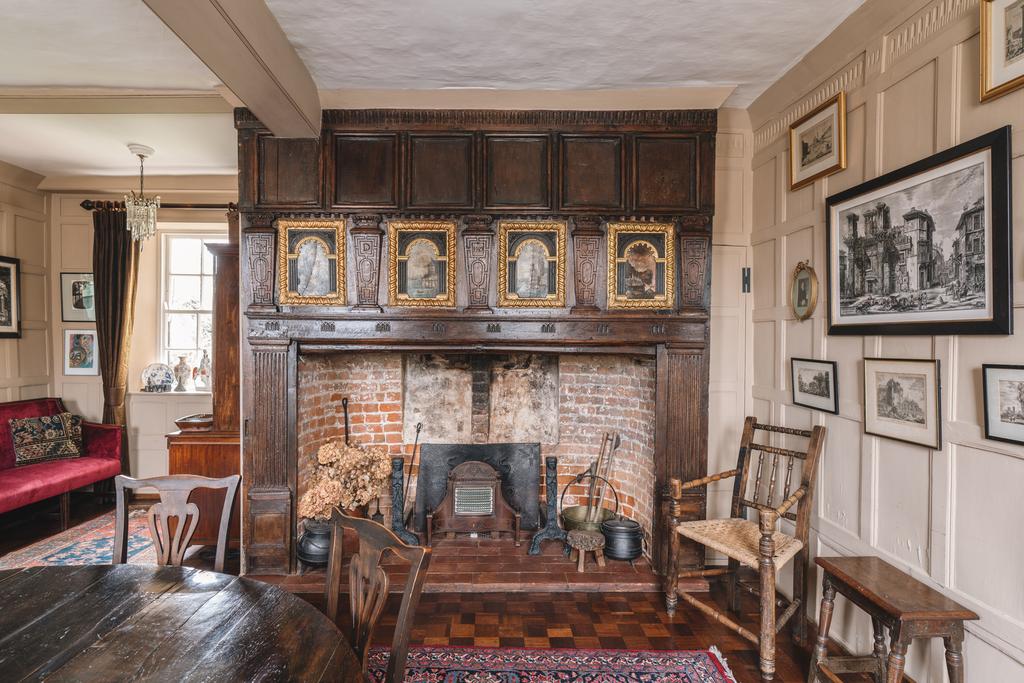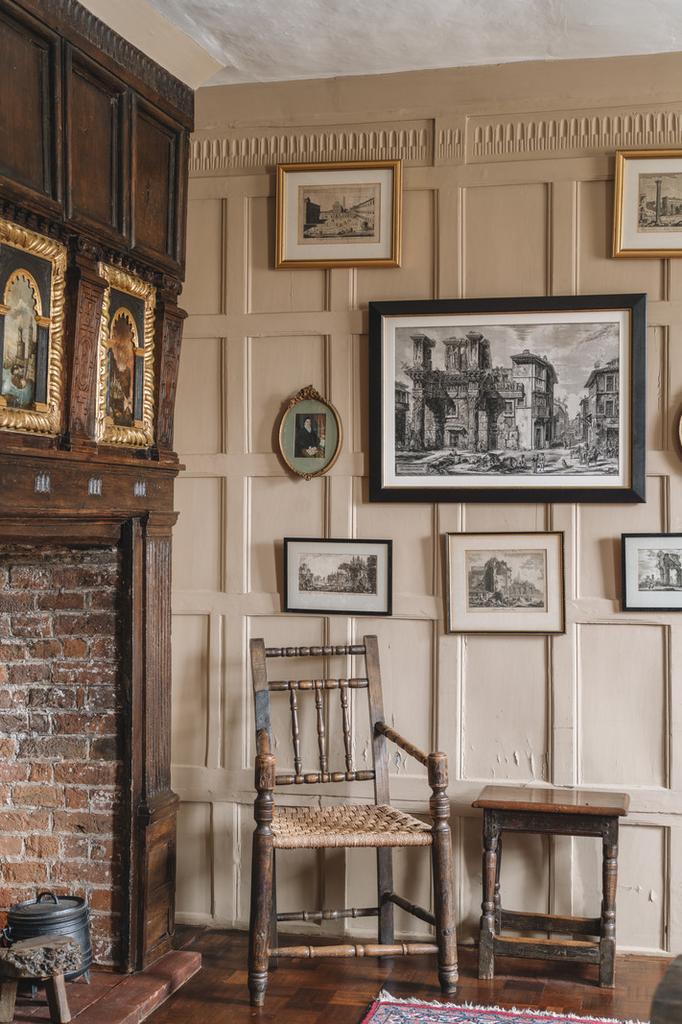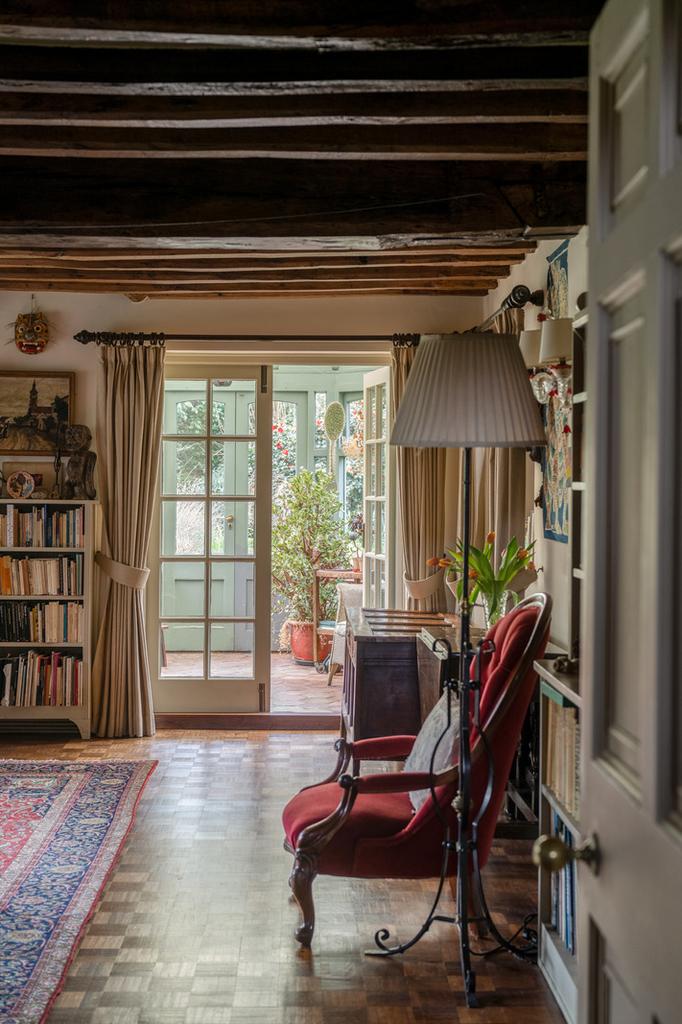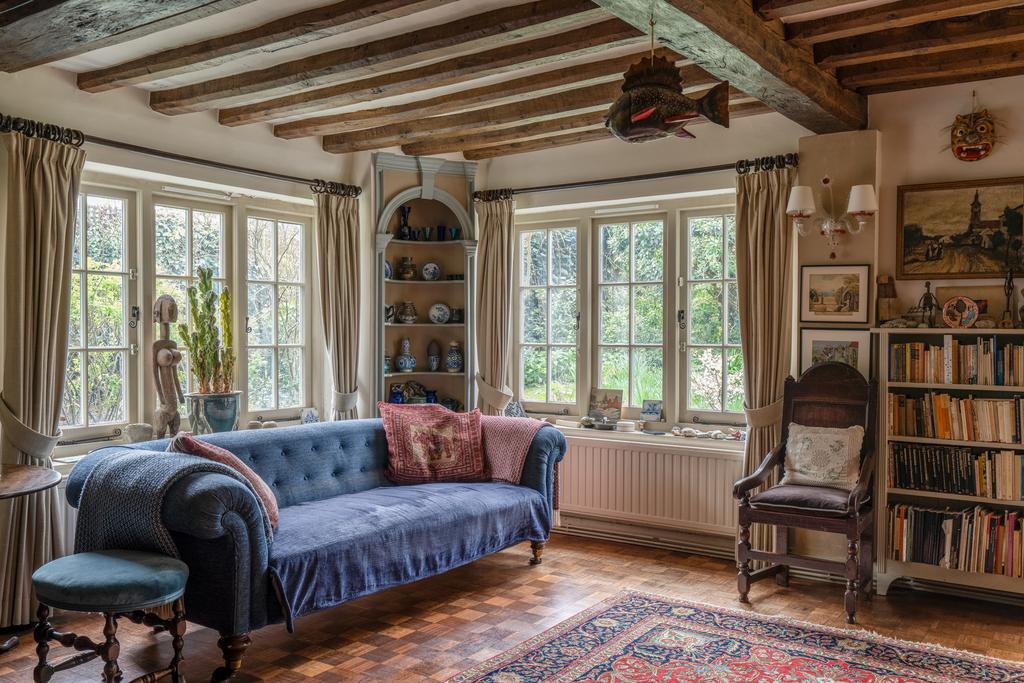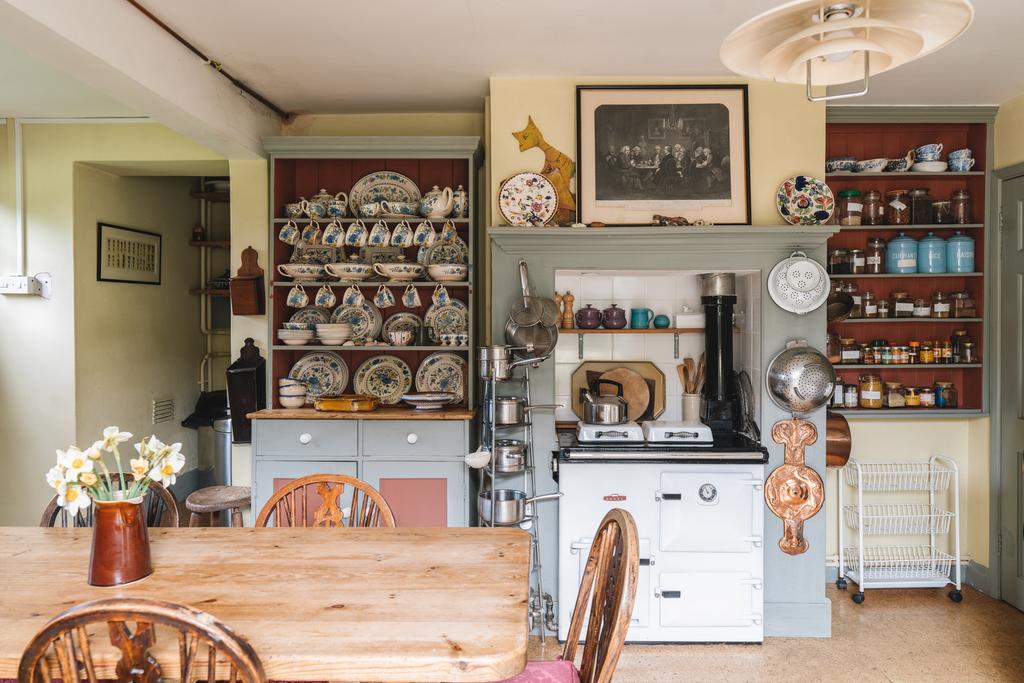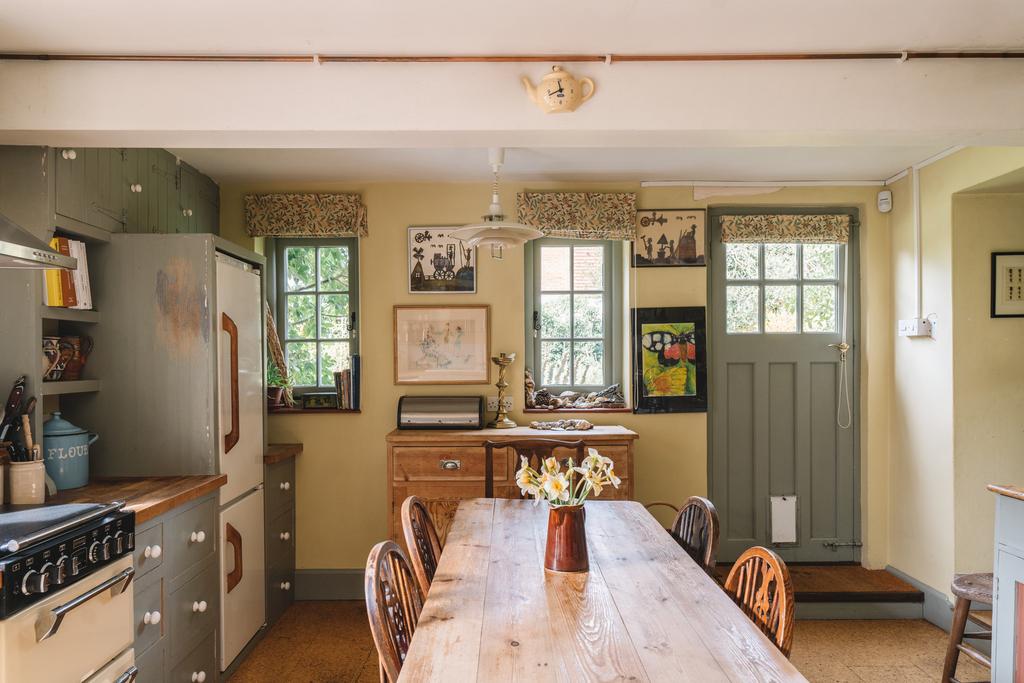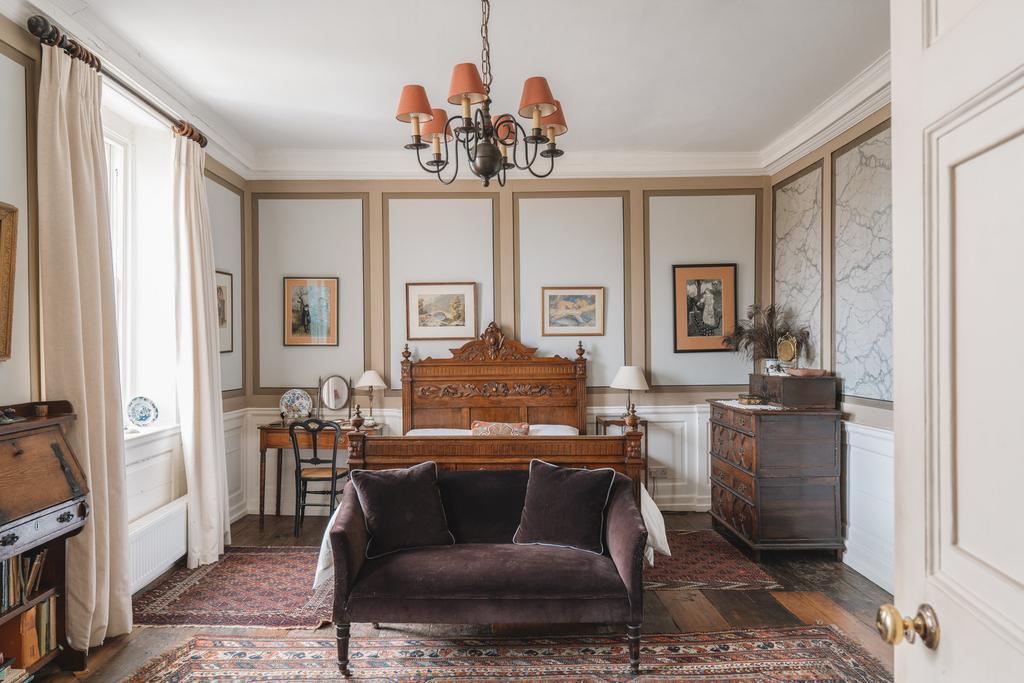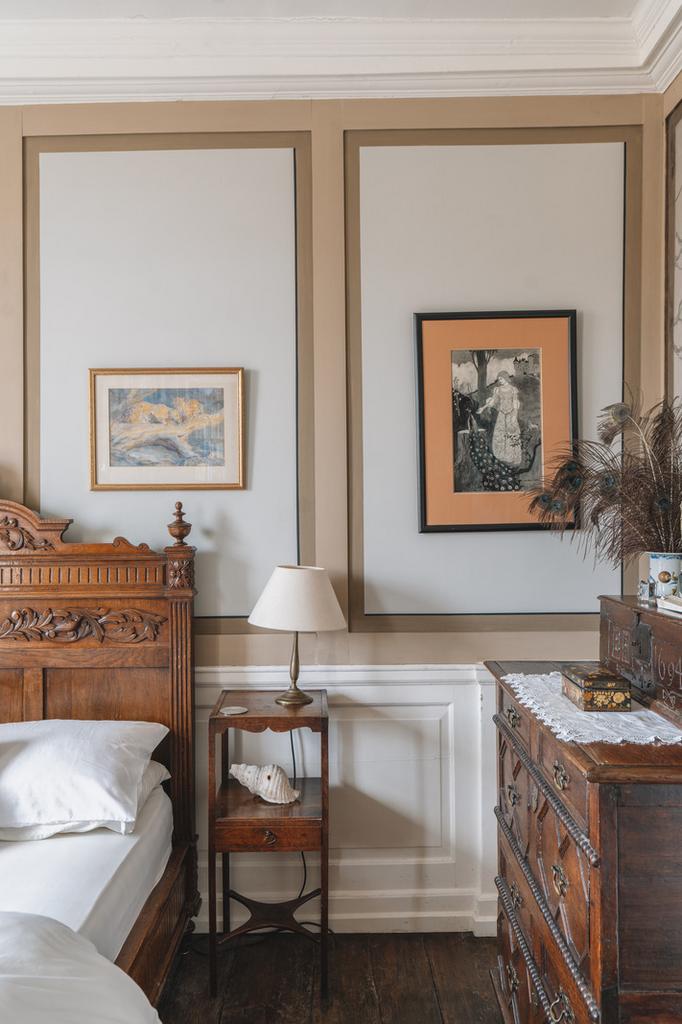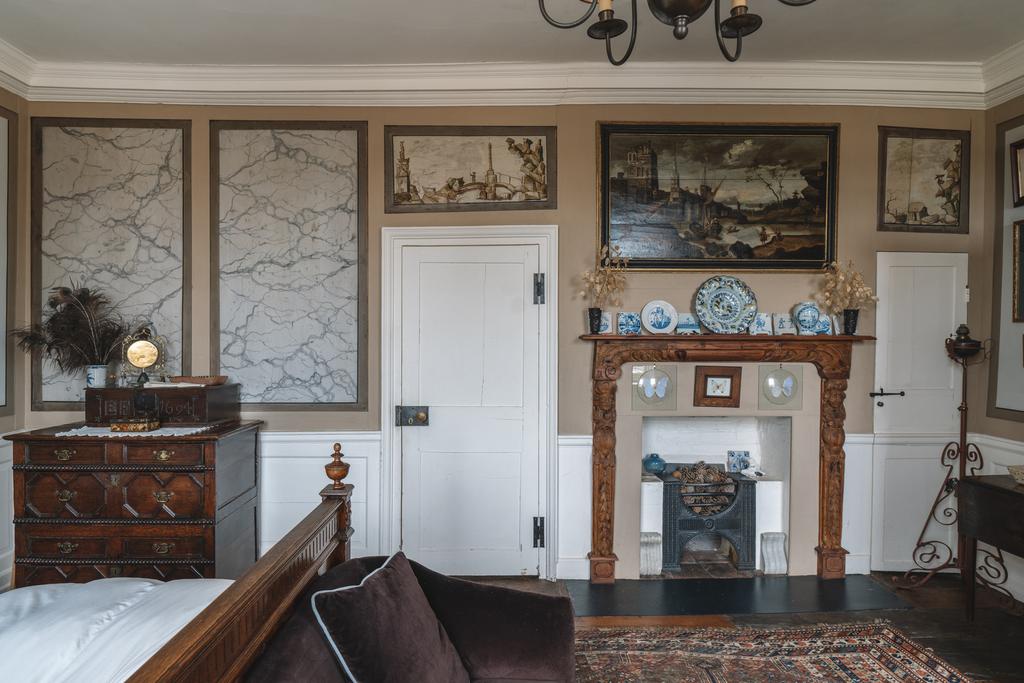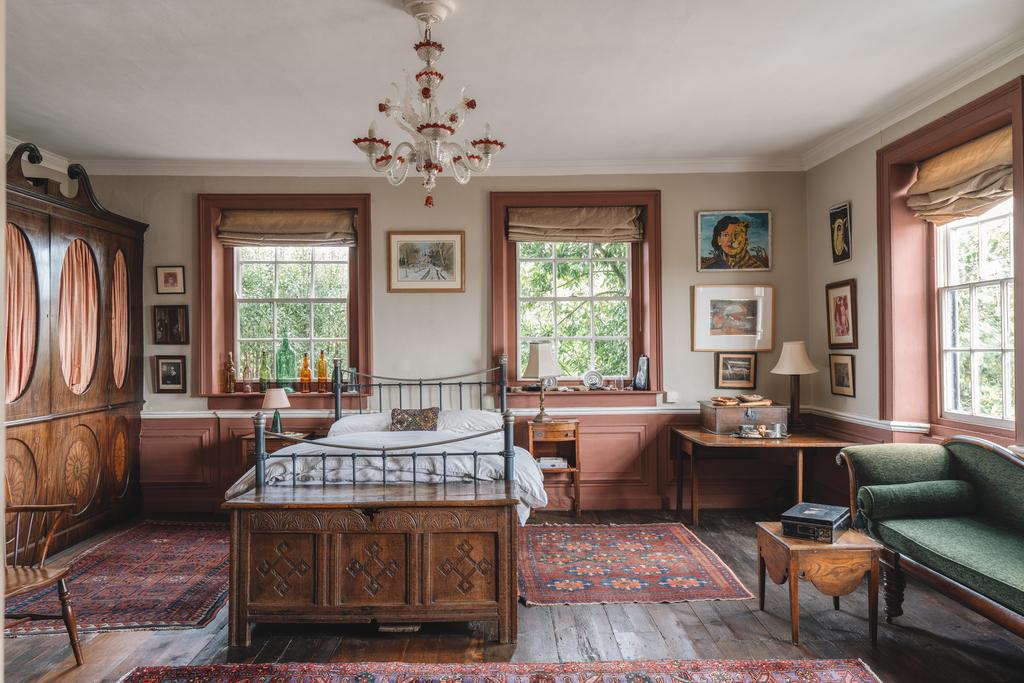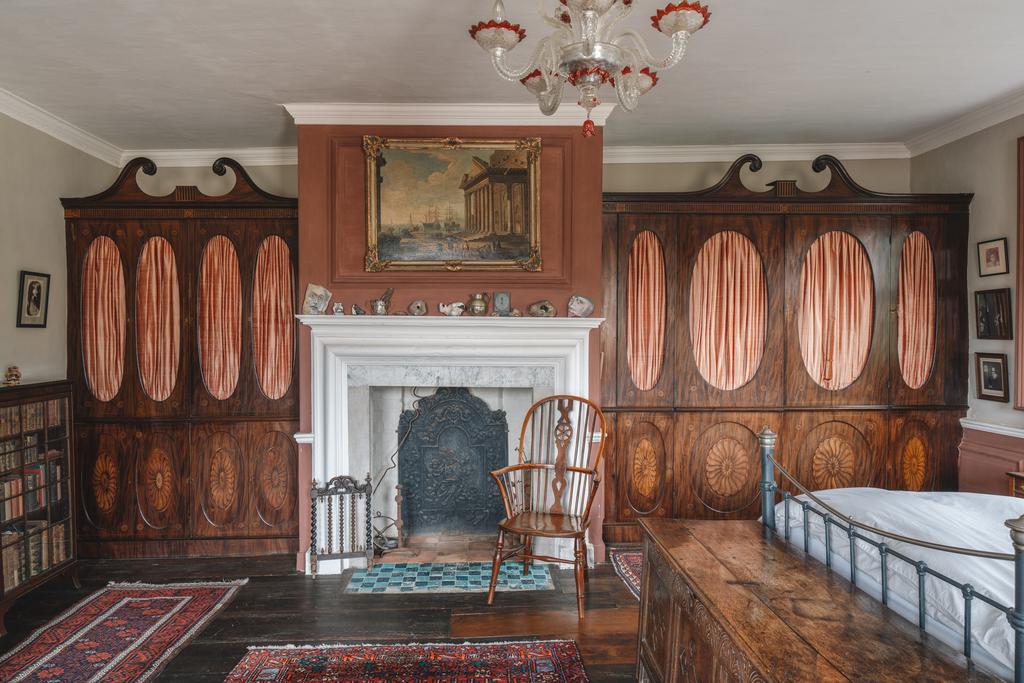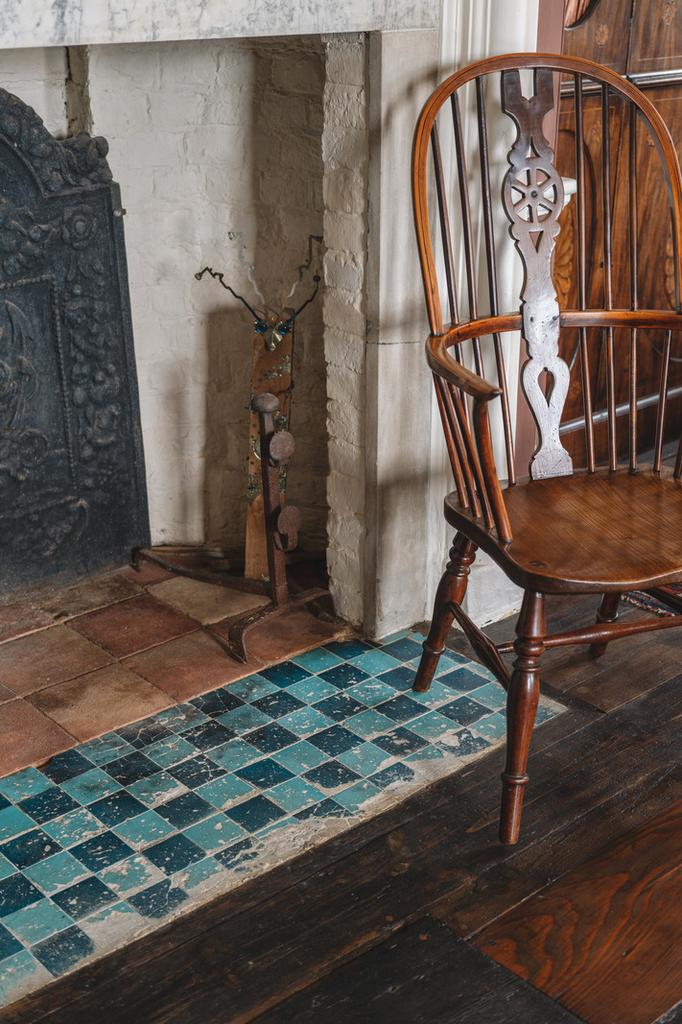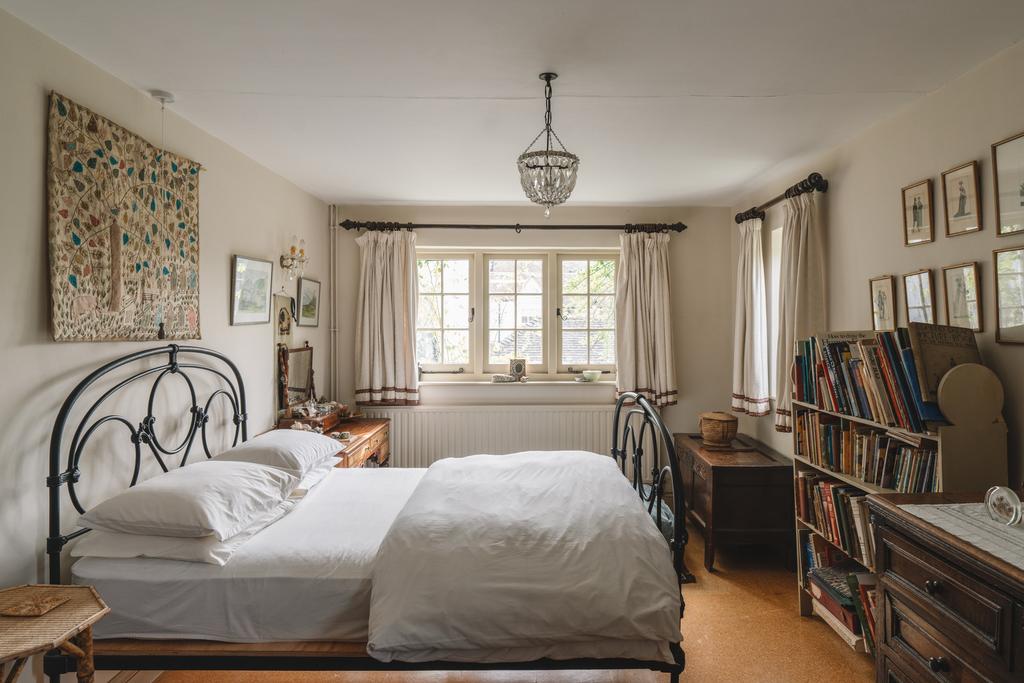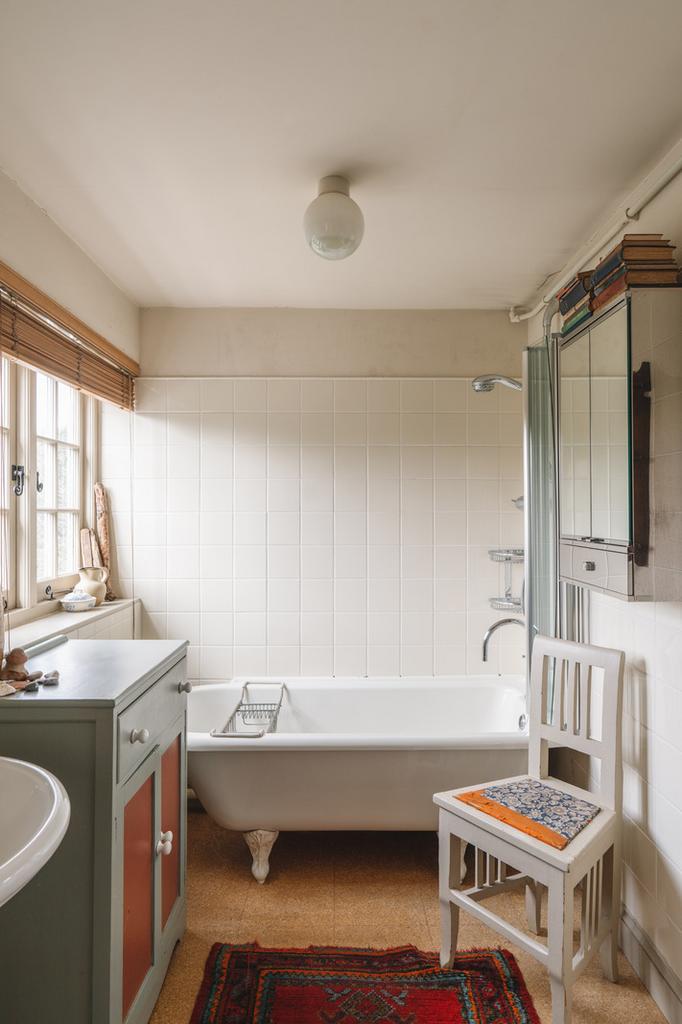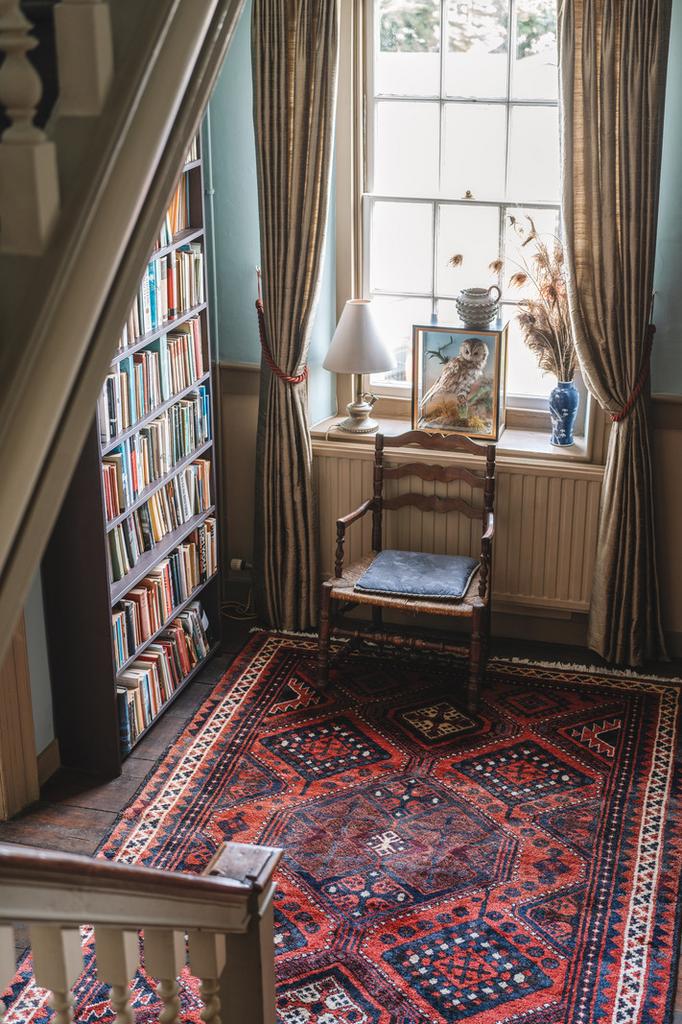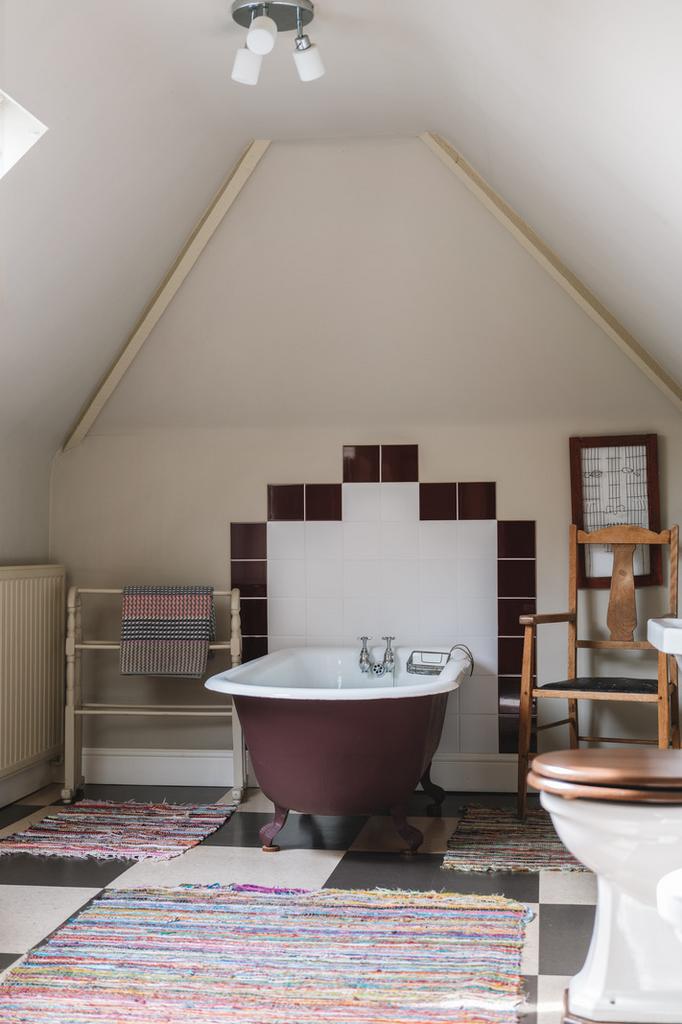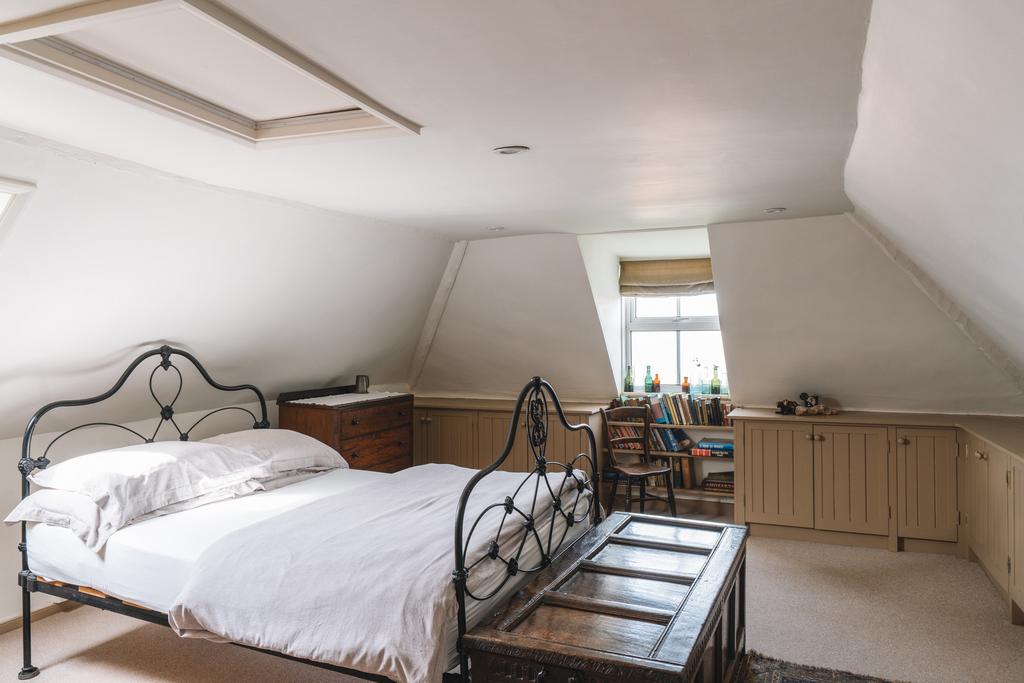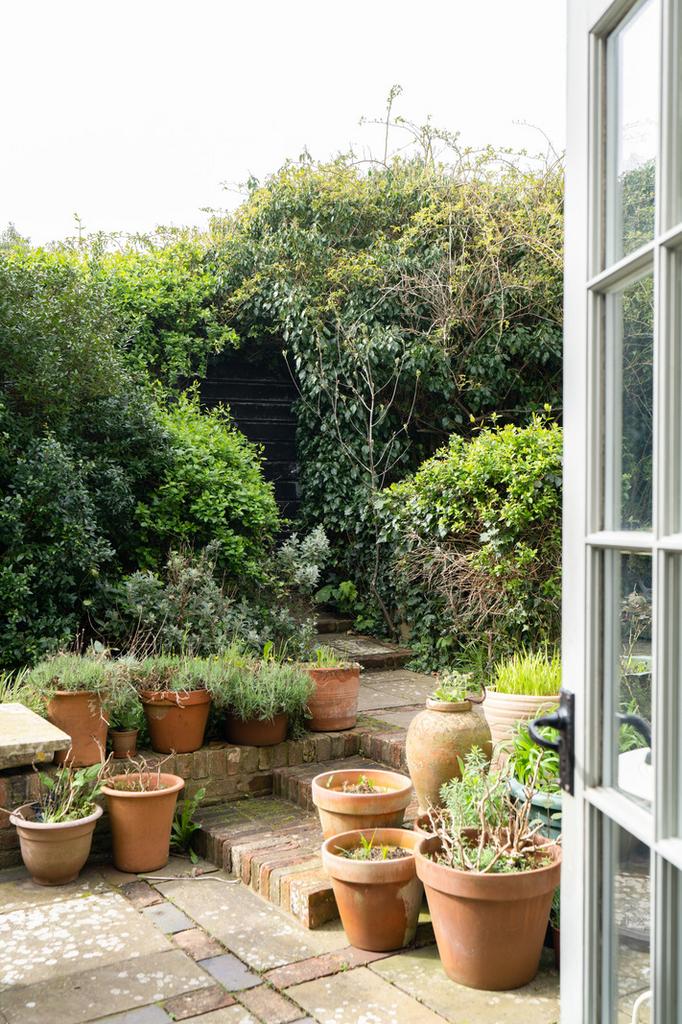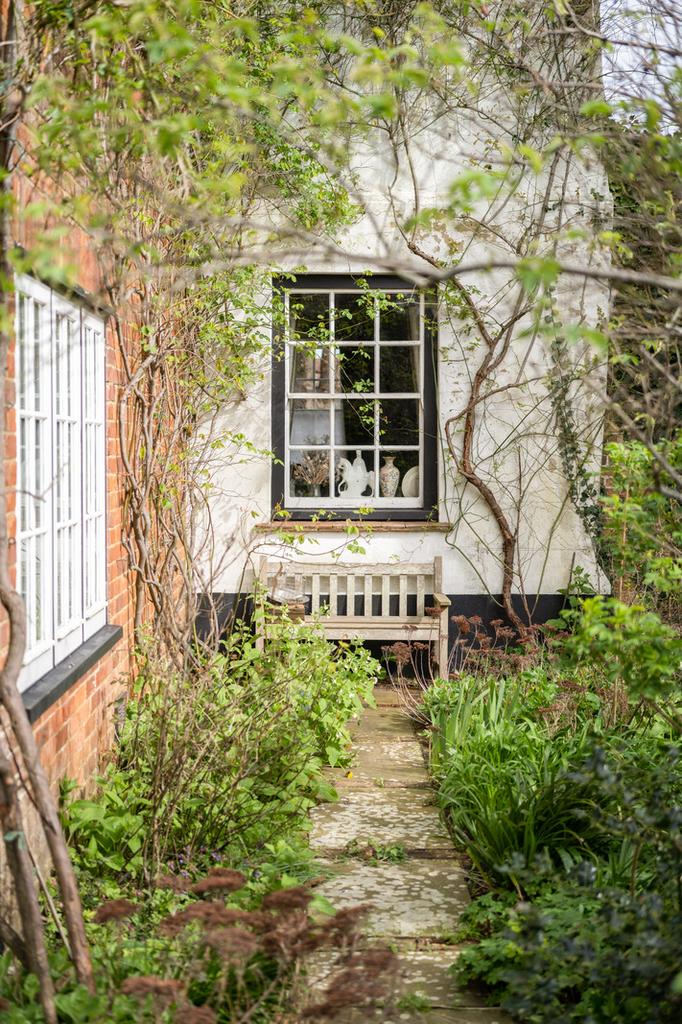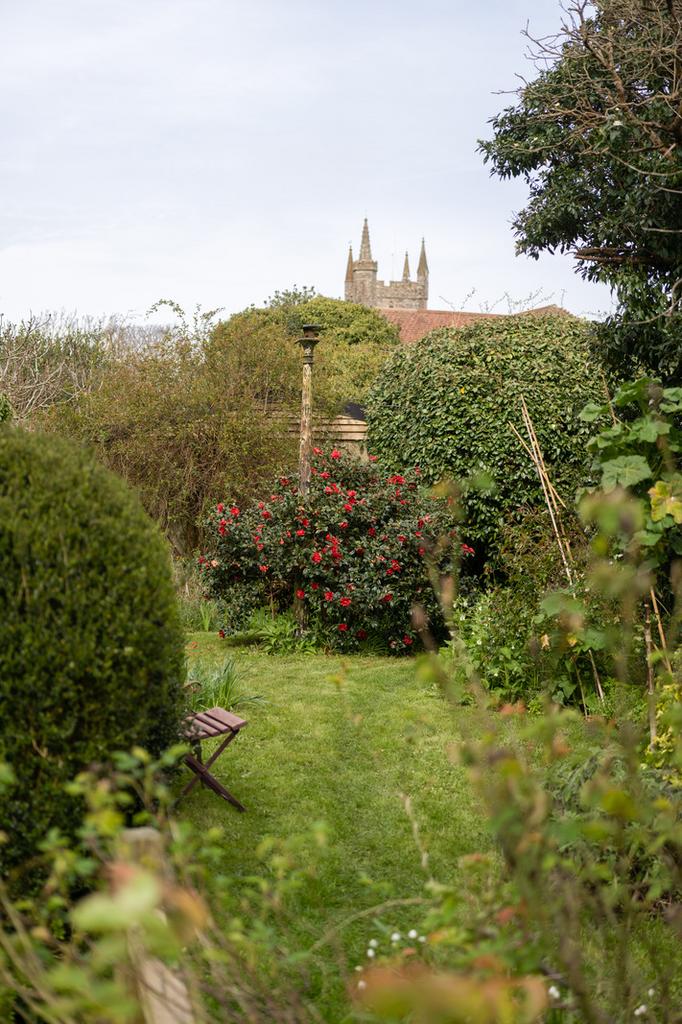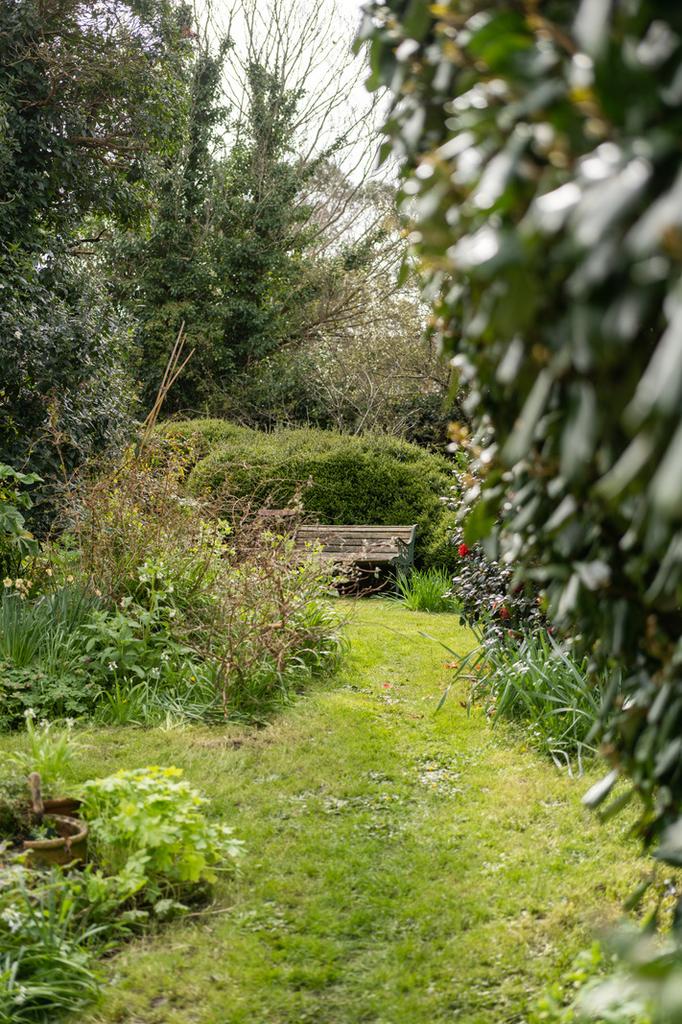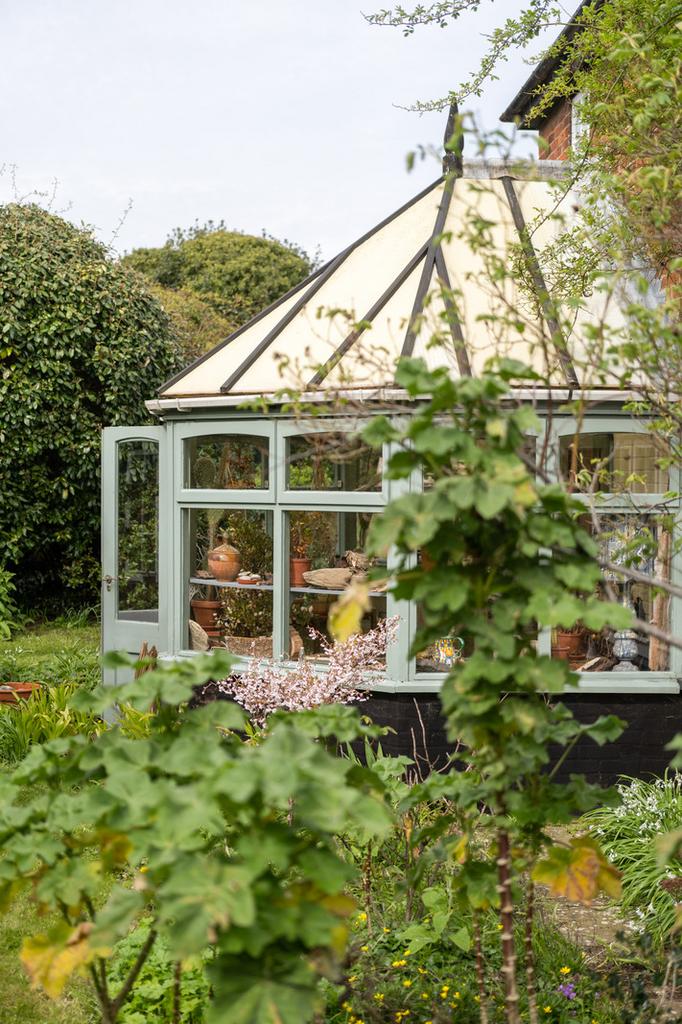6 bedroom detached house
Study
Detached house
6 beds
4 baths
5,126 sq ft / 476 sq m
Key information
Tenure: Freehold
Council tax: Ask agent
Features and description
- Tenure: Freehold
This magnificent Grade II-listed six-bedroom house is situated centrally in the village of Lydd, on Kent’s Romney Marsh. Dating to the 16th century, the house is adorned with exceptional original features that have been carefully restored and preserved by the current owners, including fine timber panelling, intricate wall paintings and ornate carved fireplaces. Outside, a lush garden billows with roses, wisteria and old fruit trees. The delights of the Kent coast, including Dungeness, Camber Sands and Rye, are nearby.
Setting the Scene
The house occupies a central position in Lydd. Facing the street, its white stucco frontage is decorated with black-painted toothed quoins, a matching string course and modillion eaves cornice. Sash windows are topped with keystones and arranged in a symmetrical composition around a doorcase with corbel brackets supporting a shallow hood. While the year ‘1695’ is inscribed on the façade, the origins of the house are believed to be earlier, dating to the 16th century. For more information, please see the History section.
The Grand Tour
Sitting between holly hedges is the blue-painted six-panel front door set with brass furniture and a four-paned rectangular transom light. It opens to a generous hallway with walls finished in a rich blue by Farrow & Ball and with reception rooms on either side. Here, a striking trompe-l’oeil effect on the wooden wall panelling, thought to date to the 18th century, has been carefully restored. A basketweave parquet floor runs throughout the hallway and the ground-floor reception rooms.
To the right is the drawing room, where light pours through a pair of sash windows and the panes of the French doors to the side garden. A box cornice tops fully panelled walls that frame intricate landscape compositions painted directly onto the fabric of the room. One of these paintings stretches above a fireplace with a moulded surround, mantle and a wood-burning stove inside atop a stone hearth. There are 12 such artworks found throughout the house; believed to be the work of an itinerant Dutch artist, they have been sensitively restored.
On the other side of the hall is the dining room, where sash windows overlook the front of the house and the David Austin roses in the rear garden. In typical Tudor fashion, the walls are clad with timber panelling and a carved frieze, washed in a warm hue. At one side of the room, nestled between blue-painted carved pilasters, is an arched alcove with shelving ideal for displaying favourite crockery and ceramics. On the other, a fireplace surround is exquisitely carved with fluted pilaster jambs and an overmantel, dentil cornice and Dutch paintings, providing a wonderful backdrop to an evening dinner party.
The hallway leads to the rear of the plan, where the sitting room, kitchen and handy WC are. The sitting room has an intimate feel; oak beams run overhead and a wood-burning stove sits in an inglenook fireplace. French doors open to a bright conservatory, the green-painted frame complemented by the earthen tones of the terracotta floor. The doors in the conservatory can be thrown open to the garden, allowing the heady scent of the roses into the room.
Doors from the kitchen also open to the garden, making it easy to pop out and pick fresh herbs when preparing a meal. Cork floor tiles run underfoot, and the kitchen is composed of timber cabinetry set with a gas Rayburn range, a four-ring gas cooker and a ceramic sink. Pottery and glassware can be stored on open shelves, and there is a good pantry store for keeping dry ingredients.
A plush carpet runs up the dark pine staircase that ascends to the first floor. On this floor, there are four double bedrooms, a family bathroom and a laundry/utility room. The primary bedroom is to the front of the plan, decoratively painted with muted tones and further trompe-l’œil patterns, this time in a marble effect. Three landscapes embellish the walls, a triptych composed of two informal studies made in preparation for the final panel. An en suite shower room adjoins.
Across the hall is the second bedroom. Wainscot panelling and the surrounds of four sash windows are painted in a red shade from Farrow & Ball, the warm shade mirrored in the gathered fabric of the bespoke built-in mahogany wardrobes. A fireplace surround with Cararra marble slips frames a hearth of striking blue mosaic tiles that complement the otherwise gentle tones of the room. At the rear of the plan are two further double bedrooms, one currently arranged as a study. The family bathroom on this floor has a roll-top bathtub beneath a casement window to the garden and a wall of neat, cream tiles.
On the second floor is another bathroom, as well as two double bedrooms tucked in the eaves of the house, both with excellent built-in storage.
The Great Outdoors
A mature garden unfolds from the rear of the house, divided into three distinct parts. At one side a lawn is surrounded by established laurel and holly trees and herbaceous borders, and there are beds of acanthus mollis and snakehead fritillaries in the centre. In the spring plantings of snowdrops, tulips and daffodils bloom. To one side of the lawn, purple flowering wisteria falls over a wooden pergola, a perfect spot for a table and chairs to enjoy a meal outside in the warmer months.
The central lawn is lush with fruiting apple and a large camellia blooming with bright red flowers each year. Here, there is a potting shed good for keeping seeds, bulbs and watering cans. To the left is a rose garden teeming with English varieties such as Gertrude Jekyll and Rosa Mundi that climb the rear of the house and provide sweet scents.
For parking, there is a garage with space for two cars.
At the rear of the garden there is an additional plot available through separate negotiation. Named ‘the secret garden’ by the current owners, the plot extends to approximately 0.088 acres and has a double garage and a potting shed.
Out and About
Lydd is surrounded by vast expanses of wetlands, shingle ridges and farmlands. The village is superbly positioned for easy access to the many highlights of the Kent and Sussex coastlines; just three miles away is Dungeness, one of the largest expanses of shingle in Europe and classified by the Met Office as Britain’s only desert. Dungeness is of international conservation importance for its geomorphology, plant and invertebrate communities and birdlife, as well as being home to Derek Jarman’s house and garden. It is part of the Site of Special Scientific Interest (SSSI) of Dungeness, Romney Marsh and Rye Bay.
To the west, the beautiful beaches at Camber, Winchelsea and Pett are only a short drive away. Rye Harbour Nature Reserve is also close by, composed of varying habitats including scrub, woodland and lagoons, and home to thousands of species of native wildlife. The expanse is a wonderful site for walking and cycling routes.
For daily amenities in Lydd, there is a grocery shop, a post office, a primary school and GP surgery, as well as several pubs and a café. In the centre of the town is the ‘Rype’, a historic green perfect for a picnic and a game of rounders, or simply enjoying a book in the sun.
The ancient Cinque Port of Rye is less than a 20-minute drive from the town. Its rich historic centre is a patchwork of cobbled streets and beautiful independent shops and cafés. Attractions include Merchant & Mills, Puckhaber, Sailors, and The Rye Bookshop. The twisting lanes are peppered with independent galleries and there is even a popular independent cinema, Kino, set within an old church building. The town has several excellent eateries including The Fig, The Lemongrass, and The Union alongside a thriving pub and café scene.
Rail connections from Rye are excellent, with branch-line train services to Brighton and Ashford offering high-speed connections to London St Pancras.
Council Tax Band: F
Setting the Scene
The house occupies a central position in Lydd. Facing the street, its white stucco frontage is decorated with black-painted toothed quoins, a matching string course and modillion eaves cornice. Sash windows are topped with keystones and arranged in a symmetrical composition around a doorcase with corbel brackets supporting a shallow hood. While the year ‘1695’ is inscribed on the façade, the origins of the house are believed to be earlier, dating to the 16th century. For more information, please see the History section.
The Grand Tour
Sitting between holly hedges is the blue-painted six-panel front door set with brass furniture and a four-paned rectangular transom light. It opens to a generous hallway with walls finished in a rich blue by Farrow & Ball and with reception rooms on either side. Here, a striking trompe-l’oeil effect on the wooden wall panelling, thought to date to the 18th century, has been carefully restored. A basketweave parquet floor runs throughout the hallway and the ground-floor reception rooms.
To the right is the drawing room, where light pours through a pair of sash windows and the panes of the French doors to the side garden. A box cornice tops fully panelled walls that frame intricate landscape compositions painted directly onto the fabric of the room. One of these paintings stretches above a fireplace with a moulded surround, mantle and a wood-burning stove inside atop a stone hearth. There are 12 such artworks found throughout the house; believed to be the work of an itinerant Dutch artist, they have been sensitively restored.
On the other side of the hall is the dining room, where sash windows overlook the front of the house and the David Austin roses in the rear garden. In typical Tudor fashion, the walls are clad with timber panelling and a carved frieze, washed in a warm hue. At one side of the room, nestled between blue-painted carved pilasters, is an arched alcove with shelving ideal for displaying favourite crockery and ceramics. On the other, a fireplace surround is exquisitely carved with fluted pilaster jambs and an overmantel, dentil cornice and Dutch paintings, providing a wonderful backdrop to an evening dinner party.
The hallway leads to the rear of the plan, where the sitting room, kitchen and handy WC are. The sitting room has an intimate feel; oak beams run overhead and a wood-burning stove sits in an inglenook fireplace. French doors open to a bright conservatory, the green-painted frame complemented by the earthen tones of the terracotta floor. The doors in the conservatory can be thrown open to the garden, allowing the heady scent of the roses into the room.
Doors from the kitchen also open to the garden, making it easy to pop out and pick fresh herbs when preparing a meal. Cork floor tiles run underfoot, and the kitchen is composed of timber cabinetry set with a gas Rayburn range, a four-ring gas cooker and a ceramic sink. Pottery and glassware can be stored on open shelves, and there is a good pantry store for keeping dry ingredients.
A plush carpet runs up the dark pine staircase that ascends to the first floor. On this floor, there are four double bedrooms, a family bathroom and a laundry/utility room. The primary bedroom is to the front of the plan, decoratively painted with muted tones and further trompe-l’œil patterns, this time in a marble effect. Three landscapes embellish the walls, a triptych composed of two informal studies made in preparation for the final panel. An en suite shower room adjoins.
Across the hall is the second bedroom. Wainscot panelling and the surrounds of four sash windows are painted in a red shade from Farrow & Ball, the warm shade mirrored in the gathered fabric of the bespoke built-in mahogany wardrobes. A fireplace surround with Cararra marble slips frames a hearth of striking blue mosaic tiles that complement the otherwise gentle tones of the room. At the rear of the plan are two further double bedrooms, one currently arranged as a study. The family bathroom on this floor has a roll-top bathtub beneath a casement window to the garden and a wall of neat, cream tiles.
On the second floor is another bathroom, as well as two double bedrooms tucked in the eaves of the house, both with excellent built-in storage.
The Great Outdoors
A mature garden unfolds from the rear of the house, divided into three distinct parts. At one side a lawn is surrounded by established laurel and holly trees and herbaceous borders, and there are beds of acanthus mollis and snakehead fritillaries in the centre. In the spring plantings of snowdrops, tulips and daffodils bloom. To one side of the lawn, purple flowering wisteria falls over a wooden pergola, a perfect spot for a table and chairs to enjoy a meal outside in the warmer months.
The central lawn is lush with fruiting apple and a large camellia blooming with bright red flowers each year. Here, there is a potting shed good for keeping seeds, bulbs and watering cans. To the left is a rose garden teeming with English varieties such as Gertrude Jekyll and Rosa Mundi that climb the rear of the house and provide sweet scents.
For parking, there is a garage with space for two cars.
At the rear of the garden there is an additional plot available through separate negotiation. Named ‘the secret garden’ by the current owners, the plot extends to approximately 0.088 acres and has a double garage and a potting shed.
Out and About
Lydd is surrounded by vast expanses of wetlands, shingle ridges and farmlands. The village is superbly positioned for easy access to the many highlights of the Kent and Sussex coastlines; just three miles away is Dungeness, one of the largest expanses of shingle in Europe and classified by the Met Office as Britain’s only desert. Dungeness is of international conservation importance for its geomorphology, plant and invertebrate communities and birdlife, as well as being home to Derek Jarman’s house and garden. It is part of the Site of Special Scientific Interest (SSSI) of Dungeness, Romney Marsh and Rye Bay.
To the west, the beautiful beaches at Camber, Winchelsea and Pett are only a short drive away. Rye Harbour Nature Reserve is also close by, composed of varying habitats including scrub, woodland and lagoons, and home to thousands of species of native wildlife. The expanse is a wonderful site for walking and cycling routes.
For daily amenities in Lydd, there is a grocery shop, a post office, a primary school and GP surgery, as well as several pubs and a café. In the centre of the town is the ‘Rype’, a historic green perfect for a picnic and a game of rounders, or simply enjoying a book in the sun.
The ancient Cinque Port of Rye is less than a 20-minute drive from the town. Its rich historic centre is a patchwork of cobbled streets and beautiful independent shops and cafés. Attractions include Merchant & Mills, Puckhaber, Sailors, and The Rye Bookshop. The twisting lanes are peppered with independent galleries and there is even a popular independent cinema, Kino, set within an old church building. The town has several excellent eateries including The Fig, The Lemongrass, and The Union alongside a thriving pub and café scene.
Rail connections from Rye are excellent, with branch-line train services to Brighton and Ashford offering high-speed connections to London St Pancras.
Council Tax Band: F
About this agent

At Inigo, we believe a beautiful home is a pleasure that never ages. We connect discerning individuals with extraordinary spaces, no matter the price or provenance. Covering urban and rural locations across Britain, our team combines proven experience selling distinctive homes with design and architectural expertise. We unlock the true value of every cottage, coach house, and conversion we represent by telling its story with in-depth features and magazine-quality photography. We take our name from Inigo Jones, the self-taught genius who kick-started a golden age of home design.
